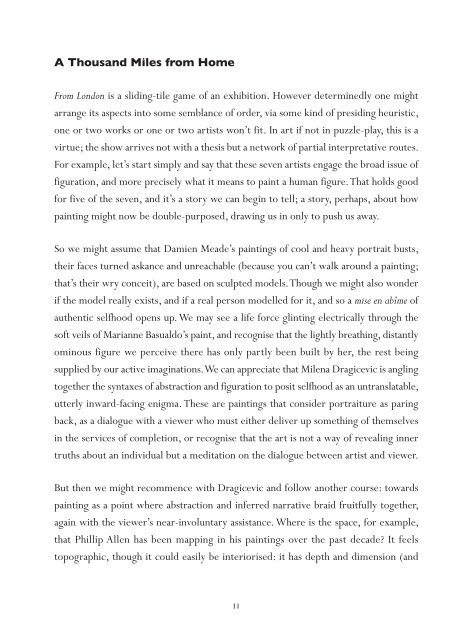Untitled - Damien Meade
Untitled - Damien Meade
Untitled - Damien Meade
Create successful ePaper yourself
Turn your PDF publications into a flip-book with our unique Google optimized e-Paper software.
A Thousand Miles from Home<br />
From London is a sliding-tile game of an exhibition. However determinedly one might<br />
arrange its aspects into some semblance of order, via some kind of presiding heuristic,<br />
one or two works or one or two artists won’t fit. In art if not in puzzle-play, this is a<br />
virtue; the show arrives not with a thesis but a network of partial interpretative routes.<br />
For example, let’s start simply and say that these seven artists engage the broad issue of<br />
figuration, and more precisely what it means to paint a human figure. That holds good<br />
for five of the seven, and it’s a story we can begin to tell; a story, perhaps, about how<br />
painting might now be double-purposed, drawing us in only to push us away.<br />
So we might assume that <strong>Damien</strong> <strong>Meade</strong>’s paintings of cool and heavy portrait busts,<br />
their faces turned askance and unreachable (because you can’t walk around a painting;<br />
that’s their wry conceit), are based on sculpted models. Though we might also wonder<br />
if the model really exists, and if a real person modelled for it, and so a mise en abîme of<br />
authentic selfhood opens up. We may see a life force glinting electrically through the<br />
soft veils of Marianne Basualdo’s paint, and recognise that the lightly breathing, distantly<br />
ominous figure we perceive there has only partly been built by her, the rest being<br />
supplied by our active imaginations. We can appreciate that Milena Dragicevic is angling<br />
together the syntaxes of abstraction and figuration to posit selfhood as an untranslatable,<br />
utterly inward-facing enigma. These are paintings that consider portraiture as paring<br />
back, as a dialogue with a viewer who must either deliver up something of themselves<br />
in the services of completion, or recognise that the art is not a way of revealing inner<br />
truths about an individual but a meditation on the dialogue between artist and viewer.<br />
But then we might recommence with Dragicevic and follow another course: towards<br />
painting as a point where abstraction and inferred narrative braid fruitfully together,<br />
again with the viewer’s near-involuntary assistance. Where is the space, for example,<br />
that Phillip Allen has been mapping in his paintings over the past decade? It feels<br />
topographic, though it could easily be interiorised: it has depth and dimension (and<br />
11


